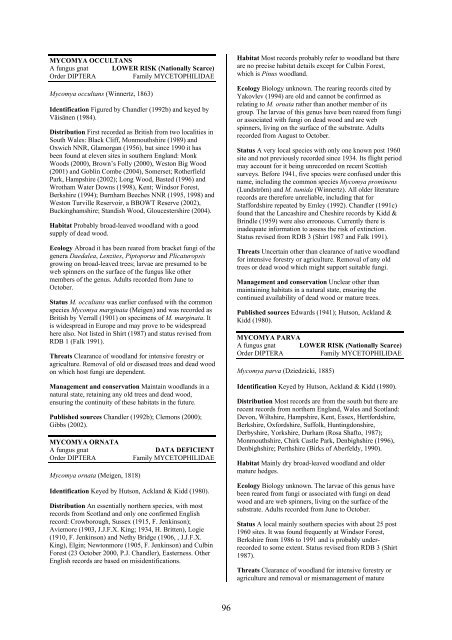Part 2: Nematocera and Aschiza not dealt with by Falk (1991) - JNCC
Part 2: Nematocera and Aschiza not dealt with by Falk (1991) - JNCC
Part 2: Nematocera and Aschiza not dealt with by Falk (1991) - JNCC
Create successful ePaper yourself
Turn your PDF publications into a flip-book with our unique Google optimized e-Paper software.
MYCOMYA OCCULTANS<br />
A fungus gnat LOWER RISK (Nationally Scarce)<br />
Order DIPTERA<br />
Family MYCETOPHILIDAE<br />
Mycomya occultans (Winnertz, 1863)<br />
Identification Figured <strong>by</strong> Ch<strong>and</strong>ler (1992b) <strong>and</strong> keyed <strong>by</strong><br />
Väisänen (1984).<br />
Distribution First recorded as British from two localities in<br />
South Wales: Black Cliff, Monmouthshire (1989) <strong>and</strong><br />
Oxwich NNR, Glamorgan (1956), but since 1990 it has<br />
been found at eleven sites in southern Engl<strong>and</strong>: Monk<br />
Woods (2000), Brown’s Folly (2000), Weston Big Wood<br />
(2001) <strong>and</strong> Goblin Combe (2004), Somerset; Rotherfield<br />
Park, Hampshire (2002); Long Wood, Basted (1996) <strong>and</strong><br />
Wrotham Water Downs (1998), Kent; Windsor Forest,<br />
Berkshire (1994); Burnham Beeches NNR (1995, 1998) <strong>and</strong><br />
Weston Turville Reservoir, a BBOWT Reserve (2002),<br />
Buckinghamshire; St<strong>and</strong>ish Wood, Gloucestershire (2004).<br />
Habitat Probably broad-leaved woodl<strong>and</strong> <strong>with</strong> a good<br />
supply of dead wood.<br />
Ecology Abroad it has been reared from bracket fungi of the<br />
genera Daedalea, Lenzites, Piptoporus <strong>and</strong> Plicaturopsis<br />
growing on broad-leaved trees; larvae are presumed to be<br />
web spinners on the surface of the fungus like other<br />
members of the genus. Adults recorded from June to<br />
October.<br />
Status M. occultans was earlier confused <strong>with</strong> the common<br />
species Mycomya marginata (Meigen) <strong>and</strong> was recorded as<br />
British <strong>by</strong> Verrall (1901) on specimens of M. marginata. It<br />
is widespread in Europe <strong>and</strong> may prove to be widespread<br />
here also. Not listed in Shirt (1987) <strong>and</strong> status revised from<br />
RDB 1 (<strong>Falk</strong> <strong>1991</strong>).<br />
Threats Clearance of woodl<strong>and</strong> for intensive forestry or<br />
agriculture. Removal of old or diseased trees <strong>and</strong> dead wood<br />
on which host fungi are dependent.<br />
Management <strong>and</strong> conservation Maintain woodl<strong>and</strong>s in a<br />
natural state, retaining any old trees <strong>and</strong> dead wood,<br />
ensuring the continuity of these habitats in the future.<br />
Published sources Ch<strong>and</strong>ler (1992b); Clemons (2000);<br />
Gibbs (2002).<br />
MYCOMYA ORNATA<br />
A fungus gnat<br />
Order DIPTERA<br />
Mycomya ornata (Meigen, 1818)<br />
DATA DEFICIENT<br />
Family MYCETOPHILIDAE<br />
Identification Keyed <strong>by</strong> Hutson, Ackl<strong>and</strong> & Kidd (1980).<br />
Distribution An essentially northern species, <strong>with</strong> most<br />
records from Scotl<strong>and</strong> <strong>and</strong> only one confirmed English<br />
record: Crowborough, Sussex (1915, F. Jenkinson);<br />
Aviemore (1903, J.J.F.X. King; 1934, H. Britten), Logie<br />
(1910, F. Jenkinson) <strong>and</strong> Nethy Bridge (1906, , J.J.F.X.<br />
King), Elgin; Newtonmore (1905, F. Jenkinson) <strong>and</strong> Culbin<br />
Forest (23 October 2000, P.J. Ch<strong>and</strong>ler), Easterness. Other<br />
English records are based on misidentifications.<br />
Habitat Most records probably refer to woodl<strong>and</strong> but there<br />
are no precise habitat details except for Culbin Forest,<br />
which is Pinus woodl<strong>and</strong>.<br />
Ecology Biology unknown. The rearing records cited <strong>by</strong><br />
Yakovlev (1994) are old <strong>and</strong> can<strong>not</strong> be confirmed as<br />
relating to M. ornata rather than a<strong>not</strong>her member of its<br />
group. The larvae of this genus have been reared from fungi<br />
or associated <strong>with</strong> fungi on dead wood <strong>and</strong> are web<br />
spinners, living on the surface of the substrate. Adults<br />
recorded from August to October.<br />
Status A very local species <strong>with</strong> only one known post 1960<br />
site <strong>and</strong> <strong>not</strong> previously recorded since 1934. Its flight period<br />
may account for it being unrecorded on recent Scottish<br />
surveys. Before 1941, five species were confused under this<br />
name, including the common species Mycomya prominens<br />
(Lundström) <strong>and</strong> M. tumida (Winnertz). All older literature<br />
records are therefore unreliable, including that for<br />
Staffordshire repeated <strong>by</strong> Emley (1992). Ch<strong>and</strong>ler (<strong>1991</strong>c)<br />
found that the Lancashire <strong>and</strong> Cheshire records <strong>by</strong> Kidd &<br />
Brindle (1959) were also erroneous. Currently there is<br />
inadequate information to assess the risk of extinction.<br />
Status revised from RDB 3 (Shirt 1987 <strong>and</strong> <strong>Falk</strong> <strong>1991</strong>).<br />
Threats Uncertain other than clearance of native woodl<strong>and</strong><br />
for intensive forestry or agriculture. Removal of any old<br />
trees or dead wood which might support suitable fungi.<br />
Management <strong>and</strong> conservation Unclear other than<br />
maintaining habitats in a natural state, ensuring the<br />
continued availability of dead wood or mature trees.<br />
Published sources Edwards (1941); Hutson, Ackl<strong>and</strong> &<br />
Kidd (1980).<br />
MYCOMYA PARVA<br />
A fungus gnat LOWER RISK (Nationally Scarce)<br />
Order DIPTERA<br />
Family MYCETOPHILIDAE<br />
Mycomya parva (Dziedzicki, 1885)<br />
Identification Keyed <strong>by</strong> Hutson, Ackl<strong>and</strong> & Kidd (1980).<br />
Distribution Most records are from the south but there are<br />
recent records from northern Engl<strong>and</strong>, Wales <strong>and</strong> Scotl<strong>and</strong>:<br />
Devon, Wiltshire, Hampshire, Kent, Essex, Hertfordshire,<br />
Berkshire, Oxfordshire, Suffolk, Huntingdonshire,<br />
Der<strong>by</strong>shire, Yorkshire, Durham (Rosa Shafto, 1987);<br />
Monmouthshire, Chirk Castle Park, Denbighshire (1996),<br />
Denbighshire; Perthshire (Birks of Aberfeldy, 1990).<br />
Habitat Mainly dry broad-leaved woodl<strong>and</strong> <strong>and</strong> older<br />
mature hedges.<br />
Ecology Biology unknown. The larvae of this genus have<br />
been reared from fungi or associated <strong>with</strong> fungi on dead<br />
wood <strong>and</strong> are web spinners, living on the surface of the<br />
substrate. Adults recorded from June to October.<br />
Status A local mainly southern species <strong>with</strong> about 25 post<br />
1960 sites. It was found frequently at Windsor Forest,<br />
Berkshire from 1986 to <strong>1991</strong> <strong>and</strong> is probably underrecorded<br />
to some extent. Status revised from RDB 3 (Shirt<br />
1987).<br />
Threats Clearance of woodl<strong>and</strong> for intensive forestry or<br />
agriculture <strong>and</strong> removal or mismanagement of mature<br />
96
















